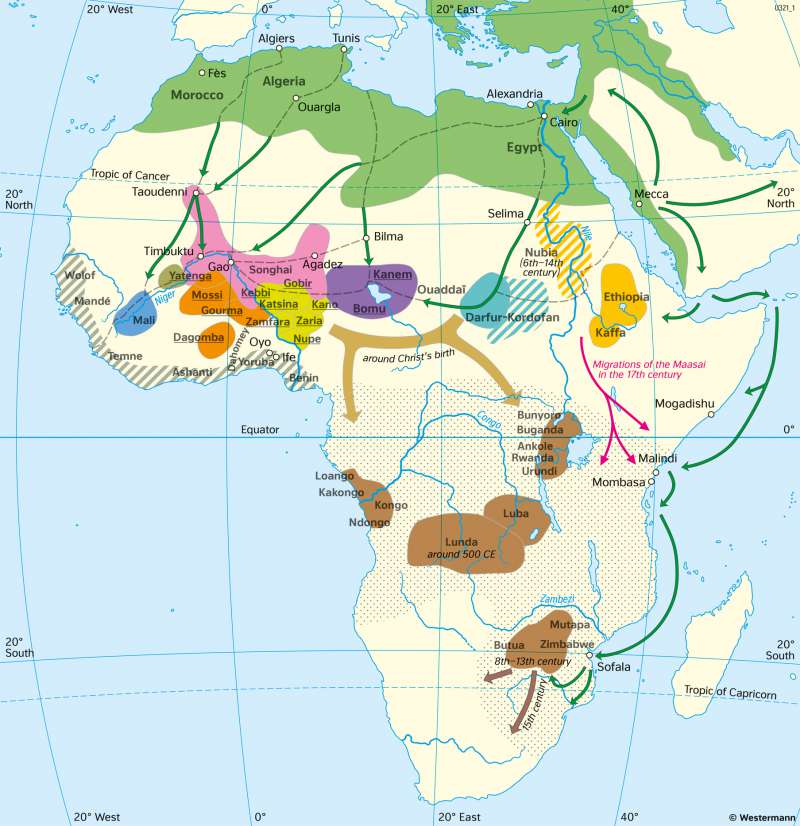Africa - Empires and territories between 15th and 17th century
History and countries
978-3-14-100890-6 | Page 144 | Ill. 1

Overview
Early modern Africa shows a belt of African empires north of the equator and scattered empires on the coasts and in the south. They were connected to the Arab-dominated north via caravan and trade routes.
Old empires and city states
The tribal princes of Mali had adopted Islam early on. Under Sundjata, the "Lion of Mali", the empire covered the area from the mouth of the Senegal to the bend of the Niger, from Walata in Mauritania to the mountains of the south. The wealth of the Malinke was based on the trans-Saharan trade and the control over the gold fields of Wangara.
In the 15th century, Mali fell to Songhai, the new great power in central Sudan. When the Songhai empire was defeated by the Moroccans and the Spanish in 1591, the era of the great Sudanese states was over. In the coastal area, new empires such as Yoruba emerged, which profited from the slave trade with the Europeans that established itself on the coast from the 16th century onwards. The Yoruba city-state of Benin developed into one of the largest slave markets.
The Hausa city-states - including Gobir, Katsina, Kano, and Zaria - emerged around 1000 and were Islamised around 1350. The Mossi kingdoms date back to the 11th or 12th century. The Kanem-Bornu empire, founded in the 8th century north of Lake Chad and already Islamised in the 11th century, reached its greatest extent around 1200. Its prosperity was based on trade between the Arab north and the empires in the west. Around 1400, the centre shifted to Bornu, where the empire experienced a new flowering in the 16th century. On the east coast, smaller Islamic states existed, such as Mogadishu, Malindi, and Mombasa, which lived from trade in natural products and slaves.
Around the time of Christ's birth, a group of peoples who called themselves "Bantu" ("people") had migrated south from central Africa, where they founded several empires. The Kongo Empire on the west coast was the centre of a series of small hegemonies linked by kinship. When the Portuguese discovered the Congo estuary in 1482, they found a flourishing state.
Little is known about the dominions in the interior of Africa. The Luba and Lunda empires, established around 500 AD, reached a heyday in the 16th century through trade with Europeans. Ruins in Uganda and Kenya bear witness to other early cultures. The Mutapa Empire south of the Zambezi lost importance shortly after contact with the Portuguese.
The Christian empires of Nubia and Ethiopia had their own development. Ethiopia was Christianised as early as the 4th century, Nubia at the latest in the 6th century. It resisted the Arab conquests in the north until 1315, in the south until 1504. Ethiopia, too, was hard pressed by the advance of Islam, but was able to maintain its independence. The eleven churches of Lalibela (13th century) carved out of the rock bear witness to its cultural flowering, as do precious wall paintings and book illuminations from the 14th and 15th centuries.




